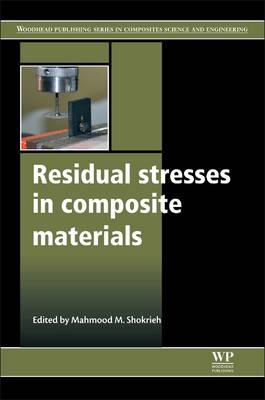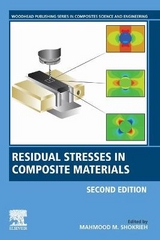
Residual Stresses in Composite Materials
Woodhead Publishing Ltd (Verlag)
978-0-85709-270-0 (ISBN)
- Titel erscheint in neuer Auflage
- Artikel merken
Residual stresses are a common phenomenon in composite materials. They can either add to or significantly reduce material strength. Because of the increasing demand for high-strength, light-weight materials such as composites and their wide range of applications in the aerospace and automotive industries, in civil infrastructure and in sporting applications, it is critical that the residual stresses of composite materials are understood and measured correctly.The first part of this important book reviews destructive and non-destructive testing (NDT) techniques for measuring residual stresses. Various mathematical (analytical and numerical) methods for calculation of residual stresses in composite materials are also presented. Chapters in the first section of the book discuss the simulated hole drilling method, the slitting/crack compliance method, measuring residual stresses in homogeneous and composite glass materials using photoelastic techniques, and modeling residual stresses in composite materials. The second part of the book discusses residual stresses in polymer matrix, metal-matrix and a range of other types of composites. Moreover, the addition of nanoparticles to the matrix of polymeric composites as a new technique for reduction of residual stresses is discussed.Residual stresses in composite materials provides a comprehensive overview of this important topic, and is an invaluable reference text for both academics and professionals working in the mechanical engineering, civil engineering, aerospace, automotive, marine and sporting industries.
Mahmood M. Shokrieh is a distinguished Professor at the School of Mechanical Engineering, Iran University of Science and Technology (IUST), Tehran, Iran. He is the founder of the Iran Scientific Composites Association and Iran Industrial Composites Association. He is the director of the Composites Research Laboratory (CRL) of the School of Mechanical Engineering of IUST. He is the Chief Editor of the Journal of Science and Technology of Composites, published by IUST. His research interests include mechanics of composite materials; mechanics of nano-composites; stress and failure analysis of composite materials; fatigue analysis of composite materials; experimental methods in composite materials; and finite element analysis.
Contributor contact details
Woodhead Publishing Series in Composites Science and Engineering
Introduction
Part I: Measurement and modelling
1. The importance of measuring residual stresses in composite materials
Abstract
1.1 Introduction
1.2 Categories of residual stresses
1.3 Effects of residual stresses
1.4 The importance of residual stress measurement
1.5 Issues in the measurement of residual stresses
1.6 Techniques for measuring residual stress in composites
2. Destructive techniques in the measurement of residual stresses in composite materials: an overview
Abstract
2.1 Introduction
2.2 The layer removal method
2.3 The Sachs (boring) method
2.4 Hole-drilling methods
2.5 The ring-core method
2.6 The cutting method
2.7 The contour method
2.8 The ply sectioning method
2.9 The radial cutting method
2.10 Matrix removal methods
2.11 Micro-indentation methods
2.12 The slitting method
2.13 The first ply failure method
2.14 The measurement of curvature method
2.15 Heating methods
2.16 Conclusions
3. Non-destructive testing (NDT) techniques in the measurement of residual stresses in composite materials: an overview
Abstract
3.1 Introduction
3.2 The X-ray diffraction method
3.3 The neutron diffraction method
3.4 The Raman spectroscopy method
3.5 The photoelasticity method
3.6 Other optical methods
3.7 The acoustic wave method
3.8 Methods based on interferometry
3.9 The cure referencing method
3.10 Measurement methods using sensors
3.11 The electrical resistance method
3.12 Conclusions
4. Measuring residual stresses in composite materials using the simulated hole-drilling method
Abstract
4.1 Introduction
4.2 The hole-drilling method in isotropic materials
4.3 The hole-drilling method in orthotropic materials
4.4 The hole-drilling method in laminated composites
4.5 Key issues in using the hole-drilling method
4.6 Conclusions
5. Measuring residual stresses in composite materials using the slitting/crack compliance method
Abstract
5.1 Introduction
5.2 The development of the slitting method
5.3 Theoretical basis
5.4 The finite element method (FEM) for calculation of compliance functions
5.5 Residual shear stresses: effects on measured strains
5.6 Case study: residual stress measurement in a carbon/epoxy laminate
5.7 Conclusions and future trends
6. Measuring residual stresses in homogeneous and composite glass materials using photoelastic techniques
Abstract
6.1 Introduction
6.2 Measuring residual stresses in axisymmetric glass articles
6.3 Measuring residual stresses in glass articles of arbitrary shape
6.4 Measuring residual stresses in automotive and building glass
6.5 Conclusions
6.6 Acknowledgement
7. Modeling residual stresses in composite materials
Abstract
7.1 Introduction
7.2 Selecting an appropriate model
7.3 The elastic behavior models
7.4 The viscoelastic behavior models
7.5 Modified classical lamination theory (CLT) for modeling residual stresses
7.6 Future trends
Part II: Residual stresses in different types of composites
8. Understanding residual stresses in polymer matrix composites
Abstract
8.1 Introduction
8.2 Formation of residual stresses
8.3 Effects of residual stresses
8.4 Methods of measurement: destructive methods
8.5 Methods of measurement: non-destructive methods
8.6 Methods of prediction
8.7 Conclusion
9. Understanding residual stresses in metal matrix composites
Abstract
9.1 Introduction
9.2 Factors affecting the magnitude and distribution of residual stresses in composites
9.3 The effects of residual stress on the failure of metal matrix composites (MMCs)
9.4 The effects of residual stress on the elevated temperature behaviour of MMCs
9.5 Future trends
10. Understanding residual stresses and fracture toughness in ceramic nanocomposites
Abstract
10.1 Introduction
10.2 Overview of ceramic nanocomposites
10.3 Residual stress inside ceramic nanocomposites
10.4 Toughening and strengthening mechanisms in ceramic nanocomposites
10.5 Surface residual stress
10.6 Future trends
11. Measuring and modelling residual stresses in polymer-based dental composites
Abstract
11.1 Introduction
11.2 Experimental and modelling approaches to study residual stresses in dental composites
11.3 Case study: the development of local stresses in four different dental composites
11.4 Further applications of the modelling approach
12. Understanding residual stresses in thick polymer composite laminates
Abstract
12.1 Introduction
12.2 Modelling the curing process in thick laminated composites
12.3 Understanding the curing process
12.4 Residual stresses in thick laminated composites
12.5 Methods of measurement of residual stresses in laminated composites
12.6 Future trends
12.7 Acknowledgments
13. Reduction of residual stresses in polymer composites using nano-additives
Abstract
13.1 Introduction
13.2 Application of nano-additives to enhance the thermal and mechanical properties of polymer composites
13.3 Case study: reduction of residual stresses in carbon/epoxy laminates using carbon nanofibres (CNFs)
13.4 Conclusions and future trends
Index
| Reihe/Serie | Woodhead Publishing Series in Composites Science and Engineering |
|---|---|
| Verlagsort | Cambridge |
| Sprache | englisch |
| Maße | 156 x 234 mm |
| Gewicht | 750 g |
| Themenwelt | Technik ► Maschinenbau |
| ISBN-10 | 0-85709-270-7 / 0857092707 |
| ISBN-13 | 978-0-85709-270-0 / 9780857092700 |
| Zustand | Neuware |
| Haben Sie eine Frage zum Produkt? |
aus dem Bereich



